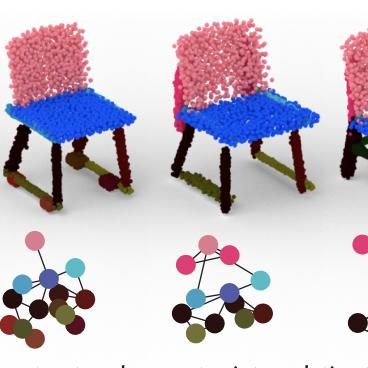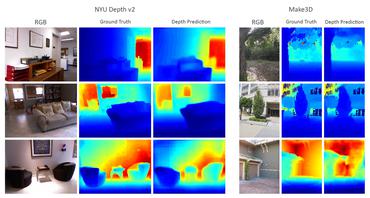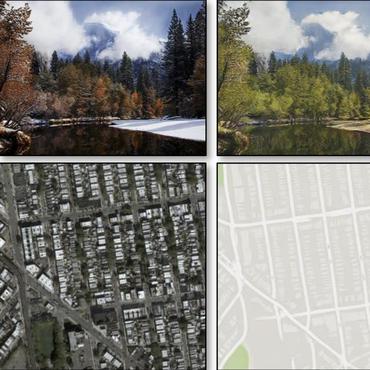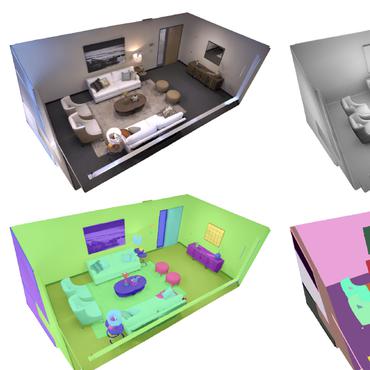Search Results for author: Manolis Savva
Found 58 papers, 30 papers with code
Linking WordNet to 3D Shapes
no code implementations • GWC 2018 • Angel X Chang, Rishi Mago, Pranav Krishna, Manolis Savva, Christiane Fellbaum
We describe a project to link the Princeton WordNet to 3D representations of real objects and scenes.
Survey on Modeling of Articulated Objects
no code implementations • 22 Mar 2024 • Jiayi Liu, Manolis Savva, Ali Mahdavi-Amiri
3D modeling of articulated objects is a research problem within computer vision, graphics, and robotics.
Text-to-3D Shape Generation
no code implementations • 20 Mar 2024 • Han-Hung Lee, Manolis Savva, Angel X. Chang
Recent years have seen an explosion of work and interest in text-to-3D shape generation.
R3DS: Reality-linked 3D Scenes for Panoramic Scene Understanding
no code implementations • 18 Mar 2024 • Qirui Wu, Sonia Raychaudhuri, Daniel Ritchie, Manolis Savva, Angel X Chang
We introduce the Reality-linked 3D Scenes (R3DS) dataset of synthetic 3D scenes mirroring the real-world scene arrangements from Matterport3D panoramas.
Generalizing Single-View 3D Shape Retrieval to Occlusions and Unseen Objects
no code implementations • 31 Dec 2023 • Qirui Wu, Daniel Ritchie, Manolis Savva, Angel X. Chang
Single-view 3D shape retrieval is a challenging task that is increasingly important with the growth of available 3D data.
CAGE: Controllable Articulation GEneration
no code implementations • 15 Dec 2023 • Jiayi Liu, Hou In Ivan Tam, Ali Mahdavi-Amiri, Manolis Savva
We address the challenge of generating 3D articulated objects in a controllable fashion.
Ego-Exo4D: Understanding Skilled Human Activity from First- and Third-Person Perspectives
1 code implementation • 30 Nov 2023 • Kristen Grauman, Andrew Westbury, Lorenzo Torresani, Kris Kitani, Jitendra Malik, Triantafyllos Afouras, Kumar Ashutosh, Vijay Baiyya, Siddhant Bansal, Bikram Boote, Eugene Byrne, Zach Chavis, Joya Chen, Feng Cheng, Fu-Jen Chu, Sean Crane, Avijit Dasgupta, Jing Dong, Maria Escobar, Cristhian Forigua, Abrham Gebreselasie, Sanjay Haresh, Jing Huang, Md Mohaiminul Islam, Suyog Jain, Rawal Khirodkar, Devansh Kukreja, Kevin J Liang, Jia-Wei Liu, Sagnik Majumder, Yongsen Mao, Miguel Martin, Effrosyni Mavroudi, Tushar Nagarajan, Francesco Ragusa, Santhosh Kumar Ramakrishnan, Luigi Seminara, Arjun Somayazulu, Yale Song, Shan Su, Zihui Xue, Edward Zhang, Jinxu Zhang, Angela Castillo, Changan Chen, Xinzhu Fu, Ryosuke Furuta, Cristina Gonzalez, Prince Gupta, Jiabo Hu, Yifei HUANG, Yiming Huang, Weslie Khoo, Anush Kumar, Robert Kuo, Sach Lakhavani, Miao Liu, Mi Luo, Zhengyi Luo, Brighid Meredith, Austin Miller, Oluwatumininu Oguntola, Xiaqing Pan, Penny Peng, Shraman Pramanick, Merey Ramazanova, Fiona Ryan, Wei Shan, Kiran Somasundaram, Chenan Song, Audrey Southerland, Masatoshi Tateno, Huiyu Wang, Yuchen Wang, Takuma Yagi, Mingfei Yan, Xitong Yang, Zecheng Yu, Shengxin Cindy Zha, Chen Zhao, Ziwei Zhao, Zhifan Zhu, Jeff Zhuo, Pablo Arbelaez, Gedas Bertasius, David Crandall, Dima Damen, Jakob Engel, Giovanni Maria Farinella, Antonino Furnari, Bernard Ghanem, Judy Hoffman, C. V. Jawahar, Richard Newcombe, Hyun Soo Park, James M. Rehg, Yoichi Sato, Manolis Savva, Jianbo Shi, Mike Zheng Shou, Michael Wray
We present Ego-Exo4D, a diverse, large-scale multimodal multiview video dataset and benchmark challenge.
LeTFuser: Light-weight End-to-end Transformer-Based Sensor Fusion for Autonomous Driving with Multi-Task Learning
1 code implementation • 19 Oct 2023 • Pedram Agand, Mohammad Mahdavian, Manolis Savva, Mo Chen
In end-to-end autonomous driving, the utilization of existing sensor fusion techniques and navigational control methods for imitation learning proves inadequate in challenging situations that involve numerous dynamic agents.
PARIS: Part-level Reconstruction and Motion Analysis for Articulated Objects
1 code implementation • ICCV 2023 • Jiayi Liu, Ali Mahdavi-Amiri, Manolis Savva
Our approach improves reconstruction relative to state-of-the-art baselines with a Chamfer-L1 distance reduction of 3. 94 (45. 2%) for objects and 26. 79 (84. 5%) for parts, and achieves 5% error rate for motion estimation across 10 object categories.
HomeRobot: Open-Vocabulary Mobile Manipulation
no code implementations • 20 Jun 2023 • Sriram Yenamandra, Arun Ramachandran, Karmesh Yadav, Austin Wang, Mukul Khanna, Theophile Gervet, Tsung-Yen Yang, Vidhi Jain, Alexander William Clegg, John Turner, Zsolt Kira, Manolis Savva, Angel Chang, Devendra Singh Chaplot, Dhruv Batra, Roozbeh Mottaghi, Yonatan Bisk, Chris Paxton
HomeRobot (noun): An affordable compliant robot that navigates homes and manipulates a wide range of objects in order to complete everyday tasks.
Habitat Synthetic Scenes Dataset (HSSD-200): An Analysis of 3D Scene Scale and Realism Tradeoffs for ObjectGoal Navigation
no code implementations • 20 Jun 2023 • Mukul Khanna, Yongsen Mao, Hanxiao Jiang, Sanjay Haresh, Brennan Shacklett, Dhruv Batra, Alexander Clegg, Eric Undersander, Angel X. Chang, Manolis Savva
Surprisingly, we observe that agents trained on just 122 scenes from our dataset outperform agents trained on 10, 000 scenes from the ProcTHOR-10K dataset in terms of zero-shot generalization in real-world scanned environments.
Evaluating 3D Shape Analysis Methods for Robustness to Rotation Invariance
no code implementations • 29 May 2023 • Supriya Gadi Patil, Angel X. Chang, Manolis Savva
Our study, on a synthetic dataset of 3D scenes where objects instances occur in different orientations, reveals that deep learning-based rotation invariant methods are effective for relatively easy settings with easy-to-distinguish pairs.
MOPA: Modular Object Navigation with PointGoal Agents
no code implementations • 7 Apr 2023 • Sonia Raychaudhuri, Tommaso Campari, Unnat Jain, Manolis Savva, Angel X. Chang
We propose a simple but effective modular approach MOPA (Modular ObjectNav with PointGoal agents) to systematically investigate the inherent modularity of the object navigation task in Embodied AI.
OPDMulti: Openable Part Detection for Multiple Objects
1 code implementation • 24 Mar 2023 • Xiaohao Sun, Hanxiao Jiang, Manolis Savva, Angel Xuan Chang
We then address this more challenging scenario with OPDFormer: a part-aware transformer architecture.
Emergence of Maps in the Memories of Blind Navigation Agents
no code implementations • 30 Jan 2023 • Erik Wijmans, Manolis Savva, Irfan Essa, Stefan Lee, Ari S. Morcos, Dhruv Batra
A positive answer to this question would (a) explain the surprising phenomenon in recent literature of ostensibly map-free neural-networks achieving strong performance, and (b) strengthen the evidence of mapping as a fundamental mechanism for navigation by intelligent embodied agents, whether they be biological or artificial.
Retrospectives on the Embodied AI Workshop
no code implementations • 13 Oct 2022 • Matt Deitke, Dhruv Batra, Yonatan Bisk, Tommaso Campari, Angel X. Chang, Devendra Singh Chaplot, Changan Chen, Claudia Pérez D'Arpino, Kiana Ehsani, Ali Farhadi, Li Fei-Fei, Anthony Francis, Chuang Gan, Kristen Grauman, David Hall, Winson Han, Unnat Jain, Aniruddha Kembhavi, Jacob Krantz, Stefan Lee, Chengshu Li, Sagnik Majumder, Oleksandr Maksymets, Roberto Martín-Martín, Roozbeh Mottaghi, Sonia Raychaudhuri, Mike Roberts, Silvio Savarese, Manolis Savva, Mohit Shridhar, Niko Sünderhauf, Andrew Szot, Ben Talbot, Joshua B. Tenenbaum, Jesse Thomason, Alexander Toshev, Joanne Truong, Luca Weihs, Jiajun Wu
We present a retrospective on the state of Embodied AI research.
Habitat-Matterport 3D Semantics Dataset
2 code implementations • CVPR 2023 • Karmesh Yadav, Ram Ramrakhya, Santhosh Kumar Ramakrishnan, Theo Gervet, John Turner, Aaron Gokaslan, Noah Maestre, Angel Xuan Chang, Dhruv Batra, Manolis Savva, Alexander William Clegg, Devendra Singh Chaplot
The scale, quality, and diversity of object annotations far exceed those of prior datasets.
Articulated 3D Human-Object Interactions from RGB Videos: An Empirical Analysis of Approaches and Challenges
1 code implementation • 12 Sep 2022 • Sanjay Haresh, Xiaohao Sun, Hanxiao Jiang, Angel X. Chang, Manolis Savva
Human-object interactions with articulated objects are common in everyday life.
OPD: Single-view 3D Openable Part Detection
1 code implementation • 30 Mar 2022 • Hanxiao Jiang, Yongsen Mao, Manolis Savva, Angel X. Chang
The input is a single image of an object, and as output we detect what parts of the object can open, and the motion parameters describing the articulation of each openable part.
Learning Body-Aware 3D Shape Generative Models
no code implementations • 13 Dec 2021 • Bryce Blinn, Alexander Ding, R. Kenny Jones, Manolis Savva, Srinath Sridhar, Daniel Ritchie
The body-shape-conditioned models produce chairs which will be comfortable for a person with the given body shape; the pose-conditioned models produce chairs which accommodate the given sitting pose.
Roominoes: Generating Novel 3D Floor Plans From Existing 3D Rooms
no code implementations • 10 Dec 2021 • Kai Wang, Xianghao Xu, Leon Lei, Selena Ling, Natalie Lindsay, Angel X. Chang, Manolis Savva, Daniel Ritchie
We then discuss different strategies for solving the problem, and design two representative pipelines: one uses available 2D floor plans to guide selection and deformation of 3D rooms; the other learns to retrieve a set of compatible 3D rooms and combine them into novel layouts.
Interpretation of Emergent Communication in Heterogeneous Collaborative Embodied Agents
no code implementations • ICCV 2021 • Shivansh Patel, Saim Wani, Unnat Jain, Alexander Schwing, Svetlana Lazebnik, Manolis Savva, Angel X. Chang
We show that the emergent communication can be grounded to the agent observations and the spatial structure of the 3D environment.
Habitat-Matterport 3D Dataset (HM3D): 1000 Large-scale 3D Environments for Embodied AI
2 code implementations • 16 Sep 2021 • Santhosh K. Ramakrishnan, Aaron Gokaslan, Erik Wijmans, Oleksandr Maksymets, Alex Clegg, John Turner, Eric Undersander, Wojciech Galuba, Andrew Westbury, Angel X. Chang, Manolis Savva, Yili Zhao, Dhruv Batra
When compared to existing photorealistic 3D datasets such as Replica, MP3D, Gibson, and ScanNet, images rendered from HM3D have 20 - 85% higher visual fidelity w. r. t.
D3D-HOI: Dynamic 3D Human-Object Interactions from Videos
2 code implementations • 19 Aug 2021 • Xiang Xu, Hanbyul Joo, Greg Mori, Manolis Savva
We evaluate this approach on our dataset, demonstrating that human-object relations can significantly reduce the ambiguity of articulated object reconstructions from challenging real-world videos.
Habitat 2.0: Training Home Assistants to Rearrange their Habitat
6 code implementations • NeurIPS 2021 • Andrew Szot, Alex Clegg, Eric Undersander, Erik Wijmans, Yili Zhao, John Turner, Noah Maestre, Mustafa Mukadam, Devendra Chaplot, Oleksandr Maksymets, Aaron Gokaslan, Vladimir Vondrus, Sameer Dharur, Franziska Meier, Wojciech Galuba, Angel Chang, Zsolt Kira, Vladlen Koltun, Jitendra Malik, Manolis Savva, Dhruv Batra
We introduce Habitat 2. 0 (H2. 0), a simulation platform for training virtual robots in interactive 3D environments and complex physics-enabled scenarios.
Mirror3D: Depth Refinement for Mirror Surfaces
1 code implementation • CVPR 2021 • Jiaqi Tan, Weijie Lin, Angel X. Chang, Manolis Savva
Despite recent progress in depth sensing and 3D reconstruction, mirror surfaces are a significant source of errors.
Plan2Scene: Converting Floorplans to 3D Scenes
1 code implementation • CVPR 2021 • Madhawa Vidanapathirana, Qirui Wu, Yasutaka Furukawa, Angel X. Chang, Manolis Savva
We address the task of converting a floorplan and a set of associated photos of a residence into a textured 3D mesh model, a task which we call Plan2Scene.
 Ranked #1 on
Plan2Scene
on Rent3D++
Ranked #1 on
Plan2Scene
on Rent3D++
Large Batch Simulation for Deep Reinforcement Learning
1 code implementation • ICLR 2021 • Brennan Shacklett, Erik Wijmans, Aleksei Petrenko, Manolis Savva, Dhruv Batra, Vladlen Koltun, Kayvon Fatahalian
We accelerate deep reinforcement learning-based training in visually complex 3D environments by two orders of magnitude over prior work, realizing end-to-end training speeds of over 19, 000 frames of experience per second on a single GPU and up to 72, 000 frames per second on a single eight-GPU machine.
LayoutGMN: Neural Graph Matching for Structural Layout Similarity
1 code implementation • CVPR 2021 • Akshay Gadi Patil, Manyi Li, Matthew Fisher, Manolis Savva, Hao Zhang
In particular, retrieval results by our network better match human judgement of structural layout similarity compared to both IoUs and other baselines including a state-of-the-art method based on graph neural networks and image convolution.
MultiON: Benchmarking Semantic Map Memory using Multi-Object Navigation
no code implementations • NeurIPS 2020 • Saim Wani, Shivansh Patel, Unnat Jain, Angel X. Chang, Manolis Savva
We propose the multiON task, which requires navigation to an episode-specific sequence of objects in a realistic environment.
Rearrangement: A Challenge for Embodied AI
no code implementations • 3 Nov 2020 • Dhruv Batra, Angel X. Chang, Sonia Chernova, Andrew J. Davison, Jia Deng, Vladlen Koltun, Sergey Levine, Jitendra Malik, Igor Mordatch, Roozbeh Mottaghi, Manolis Savva, Hao Su
In the rearrangement task, the goal is to bring a given physical environment into a specified state.
MCMI: Multi-Cycle Image Translation with Mutual Information Constraints
1 code implementation • 6 Jul 2020 • Xiang Xu, Megha Nawhal, Greg Mori, Manolis Savva
We present a mutual information-based framework for unsupervised image-to-image translation.
ObjectNav Revisited: On Evaluation of Embodied Agents Navigating to Objects
3 code implementations • 23 Jun 2020 • Dhruv Batra, Aaron Gokaslan, Aniruddha Kembhavi, Oleksandr Maksymets, Roozbeh Mottaghi, Manolis Savva, Alexander Toshev, Erik Wijmans
In particular, the agent is initialized at a random location and pose in an environment and asked to find an instance of an object category, e. g., find a chair, by navigating to it.
Sim2Real Predictivity: Does Evaluation in Simulation Predict Real-World Performance?
3 code implementations • 13 Dec 2019 • Abhishek Kadian, Joanne Truong, Aaron Gokaslan, Alexander Clegg, Erik Wijmans, Stefan Lee, Manolis Savva, Sonia Chernova, Dhruv Batra
Second, we investigate the sim2real predictivity of Habitat-Sim for PointGoal navigation.
DD-PPO: Learning Near-Perfect PointGoal Navigators from 2.5 Billion Frames
8 code implementations • ICLR 2020 • Erik Wijmans, Abhishek Kadian, Ari Morcos, Stefan Lee, Irfan Essa, Devi Parikh, Manolis Savva, Dhruv Batra
We leverage this scaling to train an agent for 2. 5 Billion steps of experience (the equivalent of 80 years of human experience) -- over 6 months of GPU-time training in under 3 days of wall-clock time with 64 GPUs.
 Ranked #1 on
PointGoal Navigation
on Gibson PointGoal Navigation
Ranked #1 on
PointGoal Navigation
on Gibson PointGoal Navigation
Relational Graph Learning for Crowd Navigation
1 code implementation • 28 Sep 2019 • Changan Chen, Sha Hu, Payam Nikdel, Greg Mori, Manolis Savva
We present a relational graph learning approach for robotic crowd navigation using model-based deep reinforcement learning that plans actions by looking into the future.
The Replica Dataset: A Digital Replica of Indoor Spaces
2 code implementations • 13 Jun 2019 • Julian Straub, Thomas Whelan, Lingni Ma, Yufan Chen, Erik Wijmans, Simon Green, Jakob J. Engel, Raul Mur-Artal, Carl Ren, Shobhit Verma, Anton Clarkson, Mingfei Yan, Brian Budge, Yajie Yan, Xiaqing Pan, June Yon, Yuyang Zou, Kimberly Leon, Nigel Carter, Jesus Briales, Tyler Gillingham, Elias Mueggler, Luis Pesqueira, Manolis Savva, Dhruv Batra, Hauke M. Strasdat, Renzo De Nardi, Michael Goesele, Steven Lovegrove, Richard Newcombe
We introduce Replica, a dataset of 18 highly photo-realistic 3D indoor scene reconstructions at room and building scale.
Habitat: A Platform for Embodied AI Research
13 code implementations • ICCV 2019 • Manolis Savva, Abhishek Kadian, Oleksandr Maksymets, Yili Zhao, Erik Wijmans, Bhavana Jain, Julian Straub, Jia Liu, Vladlen Koltun, Jitendra Malik, Devi Parikh, Dhruv Batra
We present Habitat, a platform for research in embodied artificial intelligence (AI).
 Ranked #2 on
PointGoal Navigation
on Gibson PointGoal Navigation
Ranked #2 on
PointGoal Navigation
on Gibson PointGoal Navigation
Hierarchy Denoising Recursive Autoencoders for 3D Scene Layout Prediction
no code implementations • CVPR 2019 • Yifei Shi, Angel Xuan Chang, Zhelun Wu, Manolis Savva, Kai Xu
Indoor scenes exhibit rich hierarchical structure in 3D object layouts.
Scan2CAD: Learning CAD Model Alignment in RGB-D Scans
2 code implementations • CVPR 2019 • Armen Avetisyan, Manuel Dahnert, Angela Dai, Manolis Savva, Angel X. Chang, Matthias Nießner
For a 3D reconstruction of an indoor scene, our method takes as input a set of CAD models, and predicts a 9DoF pose that aligns each model to the underlying scan geometry.
 Ranked #1 on
3D Reconstruction
on Scan2CAD
Ranked #1 on
3D Reconstruction
on Scan2CAD
On Evaluation of Embodied Navigation Agents
9 code implementations • 18 Jul 2018 • Peter Anderson, Angel Chang, Devendra Singh Chaplot, Alexey Dosovitskiy, Saurabh Gupta, Vladlen Koltun, Jana Kosecka, Jitendra Malik, Roozbeh Mottaghi, Manolis Savva, Amir R. Zamir
Skillful mobile operation in three-dimensional environments is a primary topic of study in Artificial Intelligence.
Im2Pano3D: Extrapolating 360° Structure and Semantics Beyond the Field of View
no code implementations • CVPR 2018 • Shuran Song, Andy Zeng, Angel X. Chang, Manolis Savva, Silvio Savarese, Thomas Funkhouser
We present Im2Pano3D, a convolutional neural network that generates a dense prediction of 3D structure and a probability distribution of semantic labels for a full 360 panoramic view of an indoor scene when given only a partial observation ( <=50%) in the form of an RGB-D image.
Text2Shape: Generating Shapes from Natural Language by Learning Joint Embeddings
2 code implementations • 22 Mar 2018 • Kevin Chen, Christopher B. Choy, Manolis Savva, Angel X. Chang, Thomas Funkhouser, Silvio Savarese
To this end, we first learn joint embeddings of freeform text descriptions and colored 3D shapes.
Im2Pano3D: Extrapolating 360 Structure and Semantics Beyond the Field of View
no code implementations • 12 Dec 2017 • Shuran Song, Andy Zeng, Angel X. Chang, Manolis Savva, Silvio Savarese, Thomas Funkhouser
We present Im2Pano3D, a convolutional neural network that generates a dense prediction of 3D structure and a probability distribution of semantic labels for a full 360 panoramic view of an indoor scene when given only a partial observation (<= 50%) in the form of an RGB-D image.
MINOS: Multimodal Indoor Simulator for Navigation in Complex Environments
2 code implementations • 11 Dec 2017 • Manolis Savva, Angel X. Chang, Alexey Dosovitskiy, Thomas Funkhouser, Vladlen Koltun
We present MINOS, a simulator designed to support the development of multisensory models for goal-directed navigation in complex indoor environments.
Large-Scale 3D Shape Reconstruction and Segmentation from ShapeNet Core55
1 code implementation • 17 Oct 2017 • Li Yi, Lin Shao, Manolis Savva, Haibin Huang, Yang Zhou, Qirui Wang, Benjamin Graham, Martin Engelcke, Roman Klokov, Victor Lempitsky, Yuan Gan, Pengyu Wang, Kun Liu, Fenggen Yu, Panpan Shui, Bingyang Hu, Yan Zhang, Yangyan Li, Rui Bu, Mingchao Sun, Wei Wu, Minki Jeong, Jaehoon Choi, Changick Kim, Angom Geetchandra, Narasimha Murthy, Bhargava Ramu, Bharadwaj Manda, M. Ramanathan, Gautam Kumar, P Preetham, Siddharth Srivastava, Swati Bhugra, Brejesh lall, Christian Haene, Shubham Tulsiani, Jitendra Malik, Jared Lafer, Ramsey Jones, Siyuan Li, Jie Lu, Shi Jin, Jingyi Yu, Qi-Xing Huang, Evangelos Kalogerakis, Silvio Savarese, Pat Hanrahan, Thomas Funkhouser, Hao Su, Leonidas Guibas
We introduce a large-scale 3D shape understanding benchmark using data and annotation from ShapeNet 3D object database.
Matterport3D: Learning from RGB-D Data in Indoor Environments
1 code implementation • 18 Sep 2017 • Angel Chang, Angela Dai, Thomas Funkhouser, Maciej Halber, Matthias Nießner, Manolis Savva, Shuran Song, Andy Zeng, yinda zhang
Access to large, diverse RGB-D datasets is critical for training RGB-D scene understanding algorithms.
Learning Where to Look: Data-Driven Viewpoint Set Selection for 3D Scenes
no code implementations • 7 Apr 2017 • Kyle Genova, Manolis Savva, Angel X. Chang, Thomas Funkhouser
We provide a search algorithm that generates a sampling of likely candidate views according to the example distribution, and a set selection algorithm that chooses a subset of the candidates that jointly cover the example distribution.
SceneSuggest: Context-driven 3D Scene Design
no code implementations • 28 Feb 2017 • Manolis Savva, Angel X. Chang, Maneesh Agrawala
We present SceneSuggest: an interactive 3D scene design system providing context-driven suggestions for 3D model retrieval and placement.
Graphics Human-Computer Interaction
SceneSeer: 3D Scene Design with Natural Language
no code implementations • 28 Feb 2017 • Angel X. Chang, Mihail Eric, Manolis Savva, Christopher D. Manning
We present SceneSeer: an interactive text to 3D scene generation system that allows a user to design 3D scenes using natural language.
ScanNet: Richly-annotated 3D Reconstructions of Indoor Scenes
1 code implementation • CVPR 2017 • Angela Dai, Angel X. Chang, Manolis Savva, Maciej Halber, Thomas Funkhouser, Matthias Nießner
A key requirement for leveraging supervised deep learning methods is the availability of large, labeled datasets.
 Ranked #11 on
Semantic Segmentation
on ScanNetV2
Ranked #11 on
Semantic Segmentation
on ScanNetV2
Physically-Based Rendering for Indoor Scene Understanding Using Convolutional Neural Networks
no code implementations • CVPR 2017 • Yinda Zhang, Shuran Song, Ersin Yumer, Manolis Savva, Joon-Young Lee, Hailin Jin, Thomas Funkhouser
One of the bottlenecks in training for better representations is the amount of available per-pixel ground truth data that is required for core scene understanding tasks such as semantic segmentation, normal prediction, and object edge detection.
Semantic Scene Completion from a Single Depth Image
3 code implementations • CVPR 2017 • Shuran Song, Fisher Yu, Andy Zeng, Angel X. Chang, Manolis Savva, Thomas Funkhouser
This paper focuses on semantic scene completion, a task for producing a complete 3D voxel representation of volumetric occupancy and semantic labels for a scene from a single-view depth map observation.
 Ranked #2 on
3D Semantic Scene Completion
on KITTI-360
Ranked #2 on
3D Semantic Scene Completion
on KITTI-360
ShapeNet: An Information-Rich 3D Model Repository
15 code implementations • 9 Dec 2015 • Angel X. Chang, Thomas Funkhouser, Leonidas Guibas, Pat Hanrahan, Qi-Xing Huang, Zimo Li, Silvio Savarese, Manolis Savva, Shuran Song, Hao Su, Jianxiong Xiao, Li Yi, Fisher Yu
We present ShapeNet: a richly-annotated, large-scale repository of shapes represented by 3D CAD models of objects.
Text to 3D Scene Generation with Rich Lexical Grounding
no code implementations • IJCNLP 2015 • Angel Chang, Will Monroe, Manolis Savva, Christopher Potts, Christopher D. Manning
The ability to map descriptions of scenes to 3D geometric representations has many applications in areas such as art, education, and robotics.
















